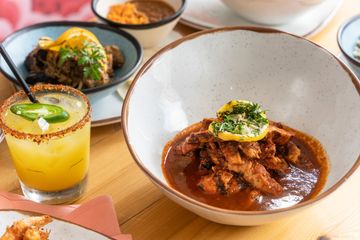Discover the heart of mexican food through traditional recipes
What Are the Vital Meals That Define Mexican Food?
Mexican food is a dynamic reflection of its cultural heritage, characterized by a variety of important dishes. Tacos, mole, pozole, tamales, and ceviche each tell an one-of-a-kind tale of custom and taste. These foods not just satisfy the palate however additionally symbolize the spirit of neighborhood and celebration. Understanding their relevance discloses much concerning Mexico's cooking identity. What exists underneath the surface of these beloved dishes?

Tacos: The Quintessential Street Food
Tacos are usually considered as the essential street food of Mexico, celebrated for their versatility and abundant tastes. They include an easy tortilla, commonly made from corn or flour, filled with a selection of active ingredients that can vary from grilled meats to vegetables. This flexibility permits for many local variations, each showcasing local flavors and practices.
Popular dental fillings include carne asada, carnitas, and pollo, often gone along with by fresh garnishes like cilantro, onions, and lime. Road vendors skillfully prepare and offer tacos, making them a budget friendly and hassle-free choice for travelers and locals alike.
The experience of eating tacos is enhanced by the lively ambience of Mexican roads, where the scent of spices and searing meat fills up the air. This iconic recipe not just satisfies appetite yet likewise represents the cultural richness of Mexico, reflecting its background, neighborhood, and cooking creativity.
Mole: A Harmony of Flavors
Mole personifies the complexity and deepness of Mexican cuisine, offering a rich tapestry of tastes that mesmerize the taste buds. This sauce, commonly made with a blend of chilies, seasonings, nuts, and chocolate, showcases the virtuosity and social heritage of Mexico. Each area boasts its distinct interpretation, with variants such as mole poblano and mole negro, showing local components and customs.
The preparation of mole is an elaborate procedure, needing ability and patience as the active ingredients are thoroughly toasted, ground, and simmered to perfection. The resulting sauce can range from mouthwatering to wonderful, with layers of flavor that evolve with each bite. Generally served over poultry or turkey, mole transcends simple sustenance, commonly enhancing special celebrations and events. Its vivid color and facility profile represent the abundant culinary identity of Mexico, making it an important dish that reverberates with both residents and visitors alike.
Pozole: A Hearty Custom
Typically taken pleasure in during festive gatherings, pozole is a recipe deeply rooted in Mexican custom, embodying both social value and common spirit. This passionate soup, made largely from hominy, meat-- generally pork or hen-- and an abundant broth, has ancient origins that trace back to pre-Columbian human beings. Traditionally planned for celebrations such as Mexican Independence Day and wedding events, pozole transcends simple sustenance, promoting a feeling of unity amongst those that take part.
The meal is available in different regional variations, consisting of pozole blanco, rojo, and verde, each identified by its distinct ingredients and taste profiles. Toppings such as shredded cabbage, radishes, avocado, and lime enhance the meal, enabling individual expression. Past its tasty qualities, pozole acts as an icon of heritage, linking generations with shared recipes and culinary techniques. Its preparation often becomes a communal occasion, strengthening bonds amongst household and friends, making it a true emblem of Mexican hospitality.
Tamales: Wrapped crazy
Tamales hold a special place in Mexican cuisine, much like pozole, commemorating tradition and area. These fascinating parcels of masa, or corn dough, are commonly full of a variety of ingredients, including meats, fruits, cheeses, or veggies, and then covered in corn husks or banana leaves prior to being steamed to excellence - tacos. The prep work of tamales commonly includes household celebrations, where generations integrated to share the labor of mixing, filling, and covering, enhancing their importance as a common recipe
Tamales are specifically popular throughout cheery celebrations, such as Christmas and Día de los Muertos, representing a link to social heritage. They are not simply food; they embody love, treatment, and the passing down of culinary skills. Each region in Mexico boasts its very own special variants, showcasing regional flavors and practices, making tamales a precious staple that goes beyond generations and joins people throughout the nation.
Ceviche: A Fresh Coastal Delight
Ceviche, a vivid recipe rooted in the coastal areas of Mexico, showcases the quality of the ocean's bounty. Commonly made with raw fish seasoned in citrus juices, specifically lime, ceviche is celebrated for its invigorating flavor account. The acidity from the lime "cooks" the fish, causing a tender texture that sets perfectly with the intense components frequently included, such as diced tomatoes, onions, cilantro, and chili peppers.
Regions like Baja California and the Yucatán Peninsula have their own unique variations, incorporating regional fish and shellfish such as shrimp, octopus, or scallops. Offered cooled, ceviche is usually come with by tortilla chips or tostadas, improving its appeal as a preferred appetiser or light meal. This recipe not only mirrors the rich aquatic life of Mexico but additionally highlights the imp source cultural significance of fresh, local ingredients in Mexican gastronomy. Ceviche stays a cherished depiction of seaside cooking practices.
Often Asked Inquiries
What Are the Key Ingredients in Conventional Mexican Cuisine?
Secret ingredients in traditional Mexican food include corn, beans, avocados, tomatoes, and chilies. hand crafted margarita. These staples form the structure of many meals, showing the dynamic tastes and varied culinary heritage of Mexico's rich gastronomic landscape
How Has Mexican Food Evolved In Time?
Mexican food has actually read the full info here developed via centuries, affected by indigenous practices, Spanish emigration, and worldwide active ingredients. This vibrant blend has actually resulted in diverse regional tastes, techniques, and meals that remain to adjust and introduce with contemporary culinary patterns.

What Are Usual Dietary Limitations in Mexican Cooking?
Typical dietary restrictions in Mexican cooking include gluten, vegetarianism, and veganism intolerance. Lots of typical dishes can be adjusted to suit these preferences, making certain that flavors continue to be vivid while appreciating specific social practices and nutritional demands.
Just How Do Regional Variations Impact Mexican Recipes?
Regional variants substantially affect Mexican meals through local ingredients, typical cooking methods, and cultural influences. Each region's special climate and background add unique flavors, methods, and recipes, resulting in an abundant cooking variety across the country.
What Beverages Set Ideal With Mexican Food?
Conventional Mexican cuisine sets well with beverages like horchata, aguas frescas, and tequila. Craft beers and mezcal additionally complement the tastes, improving the eating experience with their unique accounts and invigorating qualities.
Mexican food is a lively representation of its social heritage, characterized by a selection of necessary dishes. Mole personifies the intricacy and depth of Mexican food, using an abundant tapestry of tastes that mesmerize the taste. Frequently appreciated during cheery celebrations, pozole is a meal deeply rooted in Mexican tradition, symbolizing both cultural significance and communal spirit. Mexican food has advanced via centuries, Our site affected by indigenous practices, Spanish emigration, and worldwide ingredients. Regional variations significantly influence Mexican meals via neighborhood components, standard cooking techniques, and social impacts.